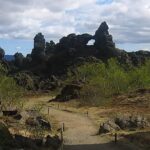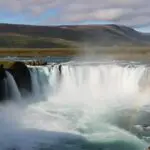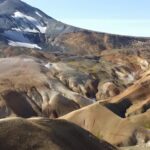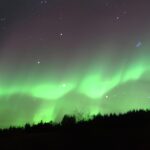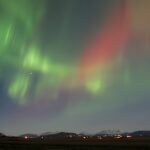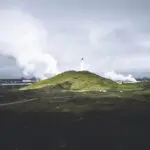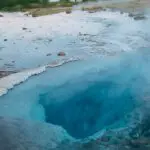On this Reykjavik Artwork Walk Around the Pond, you will get to know many of Iceland’s most important sculptors. Reykjavík has a lot of outdoor artworks maintained by the Reykjavik Art Museum. And what’s more, you can even download an app (both iOS and Android) with information and their exact location!
Beginning in Ingólfstorg, we are going to walk a circle around Hljómskálagarður Park and the Pond and end up in Ingólfstorg again.
Skúli Magnússon By Guðmundur Einarsson – 1953-1954
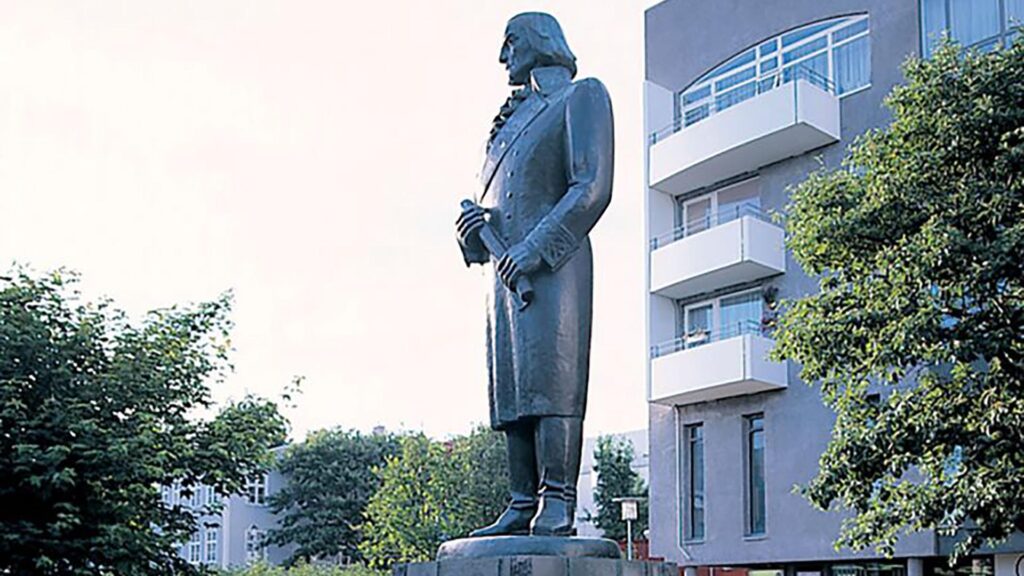
From Ingólfstorg, you will turn south and walk towards The Pond. Just a few steps away is another small square. It is called Fógetagarðurinn or The Treasurer’s Garden and is dedicated to the Father of Reykjavík, Skúli Magnússon. He was the first Icelandic treasurer and fought the Danish Monopoly diligently. In the end, it was abolished, and he was granted the right to open a wool factory in Reykjavík. It was an incentive for many people to move there. Both the oldest house and the second oldest house in Reykjavik were built because of him. Aðalstræti 10, a black house you can see from Ingólfstorg, was one of the factory houses and is the second oldest in Reykjavik. The oldest is Viðey House on Viðey Island, which was Skúli’s home as a treasurer and was built for him in the middle of the 18th century.
Memorial for Víkurkirkjugarður By Páll Guðmundsson – 2000
Fógetagarðurinn is also situated just about where Reykjavik’s oldest cemetery was once. There are sources of a church in that place going back to the 11th century. When the park was renovated in 2000, a memorial for the cemetery was erected.
The Black Cone – Monument for Civil Disobedience By Santiago Sierra – 2012
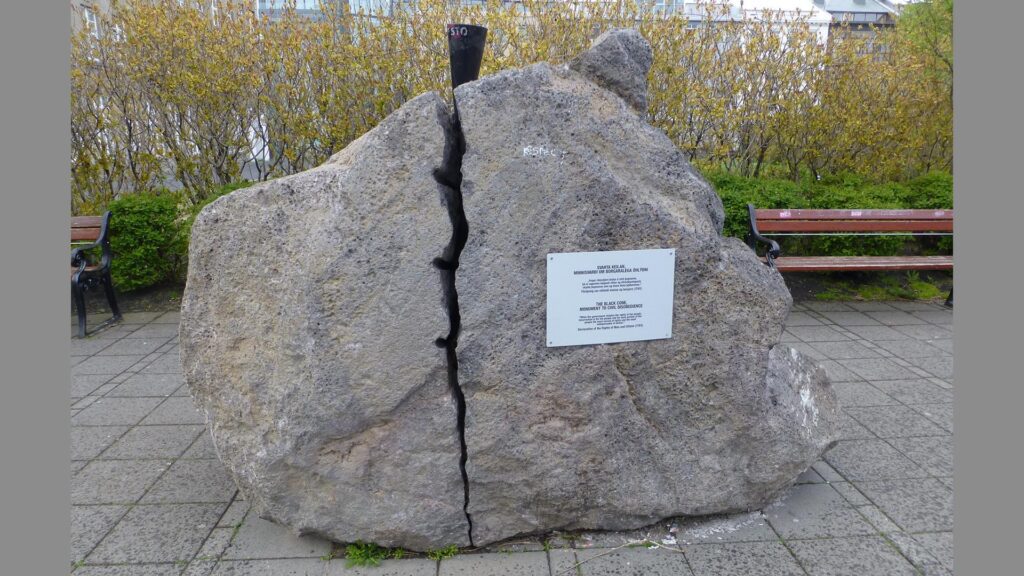
Turning left from the square, walk towards the Parliament building. On the left side, at the entrance to Austurvöllur park, is a large boulder split in two by a black cone resting in the cleft. It is the Monument for Civil Disobedience by Santiago Serra. The cone refers to the black, cone-shaped hats the Spanish Inquisition made condemned men wore in the 12th century. The artist wants to remind people of the importance of civil rights in a democratic society and the citizen’s right to refuse to obey unjust laws and demands of the authorities.
Jón Sigurðsson By Einar Jónsson – 1911
In the middle of the park is a statue of Jón Sigurðusson, the independence hero of Iceland. Einar Jónsson, one of Iceland’s most famous sculptors and author of many sculptures in the city, made this one. It originally stood in front of the Government Building in Lækjargata but was moved to Austurvöllur in 1931. Einar was not satisfied with the height of the pillar Jón was made to stand on. He felt Jón was leaning backwards.
Ingibjörg H. Bjarnason By Ragnhildur Stefánsdóttir – 2015
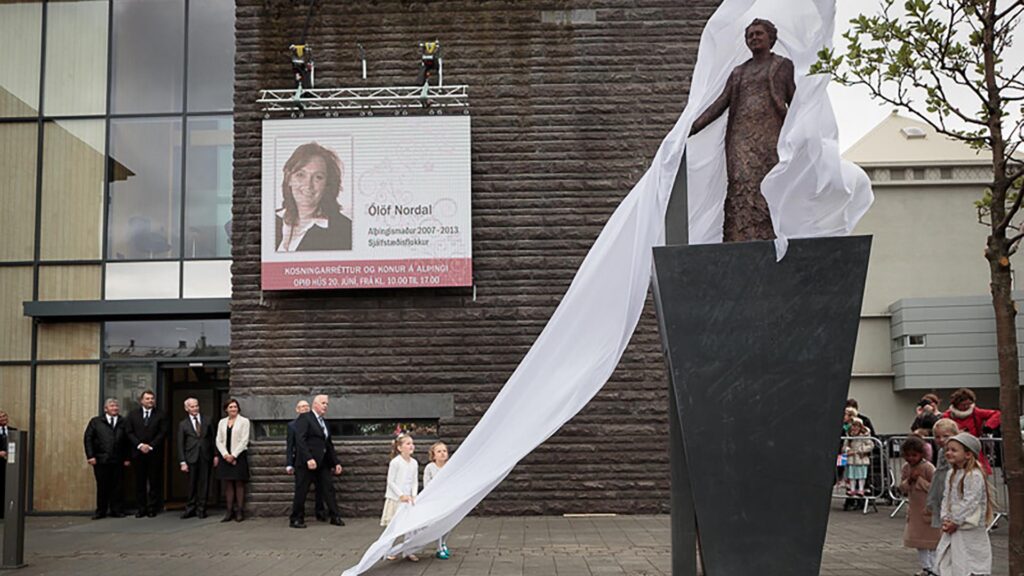
Turn around and walk to the right side of the Parliament Building. There you will see a statue of Ingibjörg H. Bjarnason. She was the first woman elected to the Icelandic Parliament in 1922. The statue was unveiled on June 19, 2015 – The 100-Anniversary of Women’s Suffrage in Iceland. It was also the first whole sculpture of a specific and named woman in Reykjavik.
Wrocław dwarf in Reykjavik
Walk between the buildings towards Reykjavik City Hall by the Pond. Turn right and left at the small Pond in front of the building. When you’re past City Hall, take the walking path next to The Pond. There you will see a small Polish dwarf statue from the city of Wrocław. They first turned up in the Polish city in 2005 and have grown since then. The history is that in 2001, a monument of a gnome was erected to commemorate the Orange Alternative on Świdnicka Street, where the group’s gatherings used to take place.
Ólafur Thors By Sigurjón Ólafsson -1967-1968
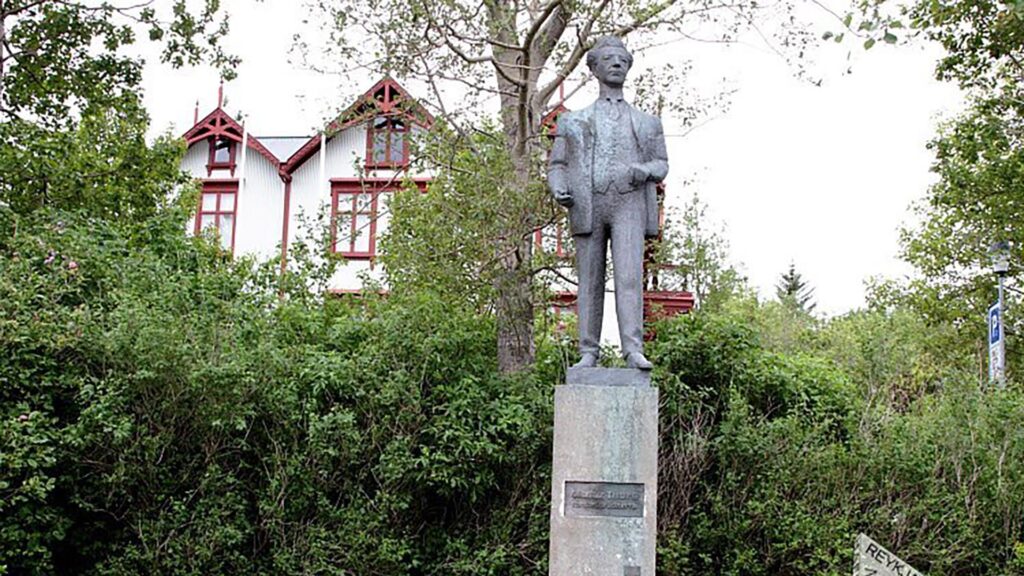
Stroll down the street and take a left turn when you can. The first statue you will come across is of Ólafur Thors. He was Prime Minister of Iceland for more than 10 years and the leader of the Independence Party longer than anyone, or for 27 years. He was the son of entrepreneur Thor Jensen (more about him later), and the statue looks The Pond over to his family home at Fríkirkjuvegur 11.
Hiroshima Peace Stone By Unknown Artist – 2004
Next to Ólafur Thors is the Hiroshima Peace Stone. It is in remembrance of those who died in the nuclear bombings of Hiroshima on August 6 and Nagasaki on August 9, 1945. The work is a gift from the Stone for Peace Association of Hiroshima. It was founded in 1991 by an ex-manager of the Hiroshima Railways at the time of the bombings.
Tómas Guðmundsson By Halla Gunnarsdóttir – 2010
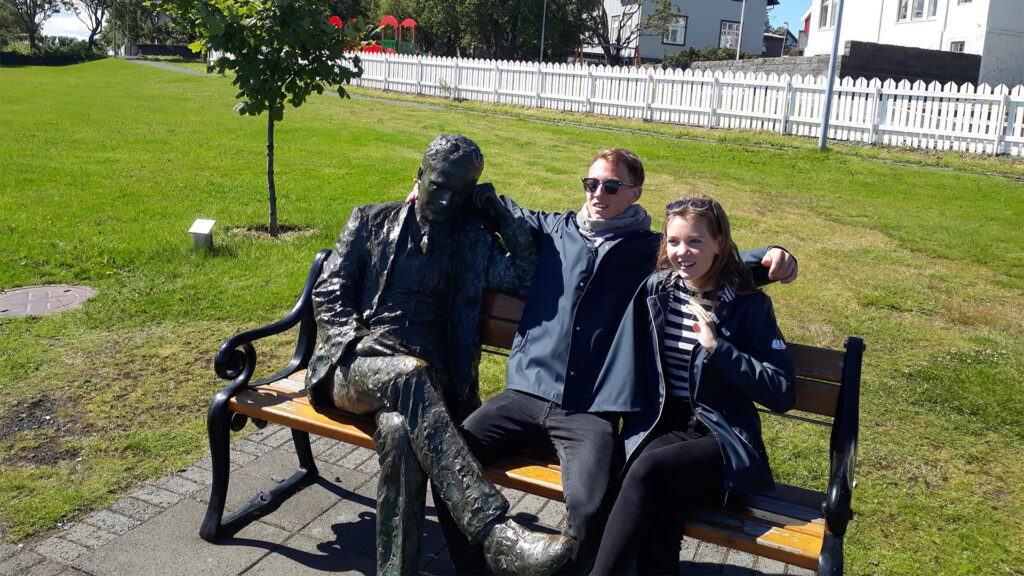
Lounging on a bench is Tómas Guðmundsson, Reykjavik’s poet. He looks calm and reflective towards the Menntaskólinn in Reykjavík (MR), where he used to study. He was in a famous class of sixteen poets, including Iceland’s only Nobel Prize winner, author Halldór Laxness.
The statue is among the stops on our Walk With a Viking Reykjavik Tour.
The Spell Broken By Einar Jónsson – 1916-1927
On the grass close to Tómas is another sculpture by Einar Jónsson. It revolves around one of his main subjects; spiritual development and the divine nature of man. In the center stands a knight, holding the handle of his sword, which he has driven straight down unto the head of a giant dragon. On one arm, the knight carries a young and naked woman who stretches out her arm, casting off the skin of an old woman; in the other, he lifts a large shield. The large body of the dragon curls up behind them. Obviously, the idea is gotten from the tale of Saint George.
Keep on strolling. Cross the street, and soon you will come to a part of the Hljómskálagarður Park called the String of Pearls. It is the women’s sculpture garden, inaugurated in June 2014. Of the many artworks in Reykjavik’s public spaces, only a few are created by women. Until 1990, there were only seven, but their number is gradually rising.
Boy and Girl (Kata and Stebbi) By Þorbjörg Pálsdóttir – 1968
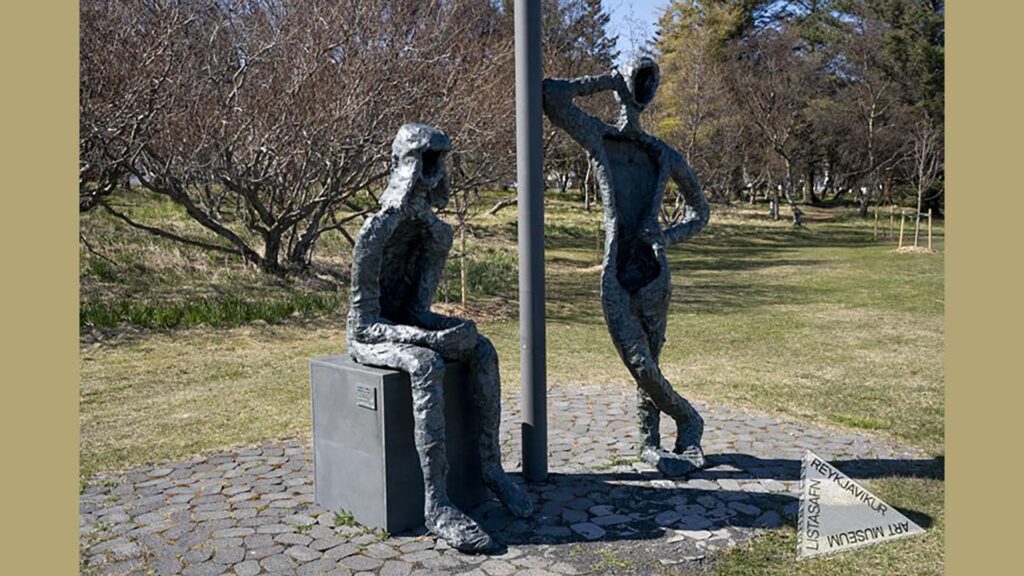
The first statue is by Þorbjörg Pálsdóttir, called Boy and Girl (Kata and Stebbi). It was one of her first sculptures, inspired by teenagers in the artist’s family who were called Kata and Stebbi. Þorbjörg’s sculptures and statues never stand on a pedestal.
Man and Woman By Tove Ólafsson – 1948
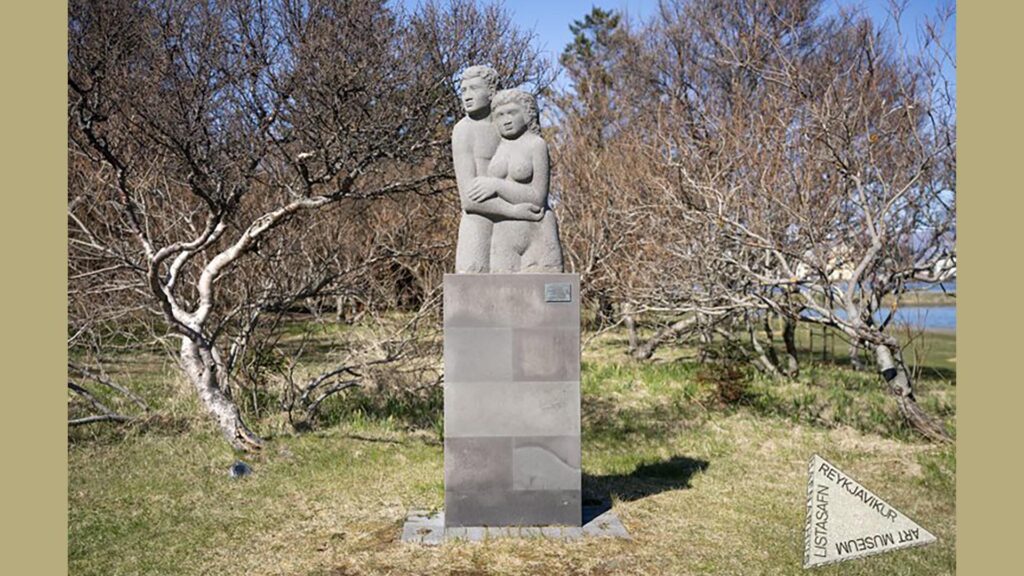
The next sculpture is called Man and Woman, made of dolerite. The statue was originally a gift to the National Theatre when it was opened in 1950. It was installed in a closed hallway off the lobby, where nobody ever went. Understandably the author, Tove Ólafsson, was not happy about this. Eventually, the theatre returned the sculpture to the city.
The Settler Woman By Gunnfríður Jónsdóttir – 1955
The top-most sculpture in this small garden, nestled between Japanese Cherry trees, is the Settler Woman. Gunnfríður was fond of Iceland’s forefathers, foremothers, and the exceptional women of the Icelandic Sagas.
Scultpture By Gerður Helgadóttir – 1968
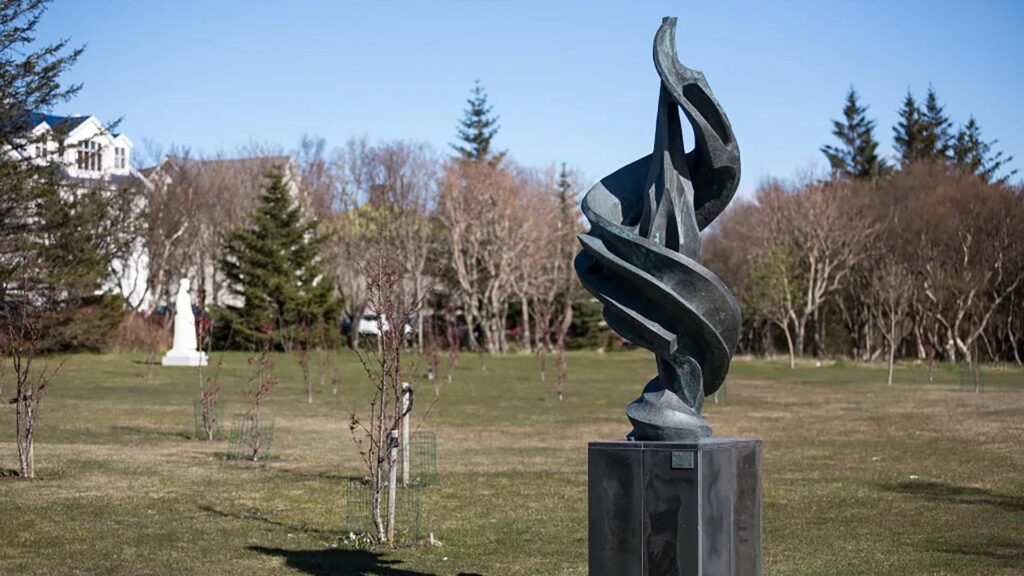
Going back down towards The Pond is a sculpture simply named sculpture. It is much more substantial than her former iron works, which resembled light filigree. The sculpture was initially installed in the Reykjavik suburb Breiðholt but was moved to Hljómskálagarðurinn in 2014.
Son By Ólöf Pálsdóttir – 1955
Ólöf said her statue Son represented the Icelandic youth.
Mermaid By Nína Sæmundsson – 1948
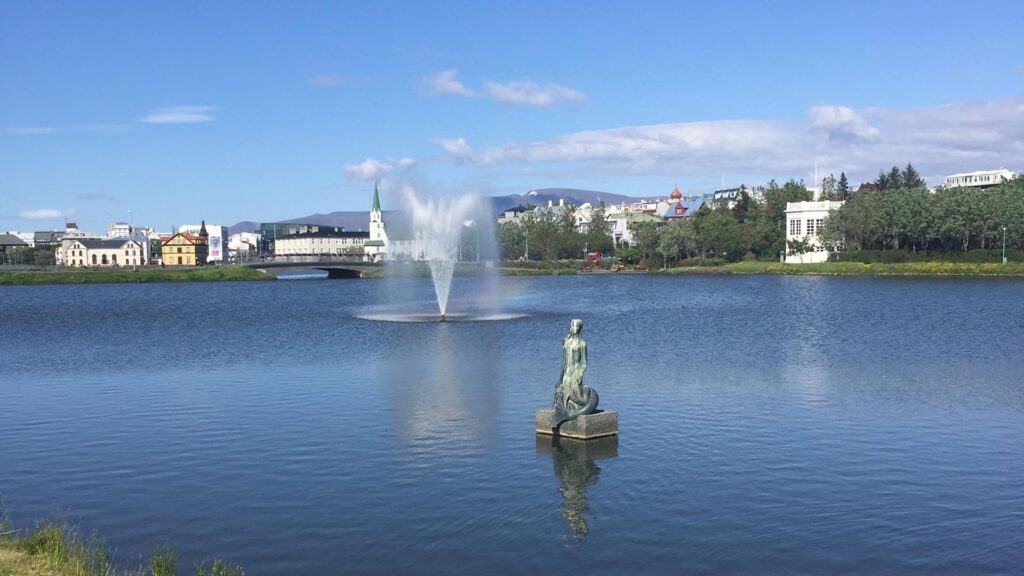
In The Pond, you will see a statue of a mermaid. This is the second time this statue has been mounted there. It was initially erected in the 1960s to many protests, but someone blew it up in the end. It was erected again in 2014.
Going home By Gunnfríður Jónsdóttir – 1947
Walk to the other side of The Pond. There you will see a small statue called Going Home. It was originally unveiled in 1947 in the sculpture garden at Sólheimar in Grímsnes in remembrance of Gunnar Ásgeirsson, a merchant and a great supporter of Sólheimar. Gunnfríður was the wife of another sculptor, Ásgrímur Sveinsson.
Bertel Thorvaldsen with the Statue of Hope By Bertel Thorvaldsen – 1839
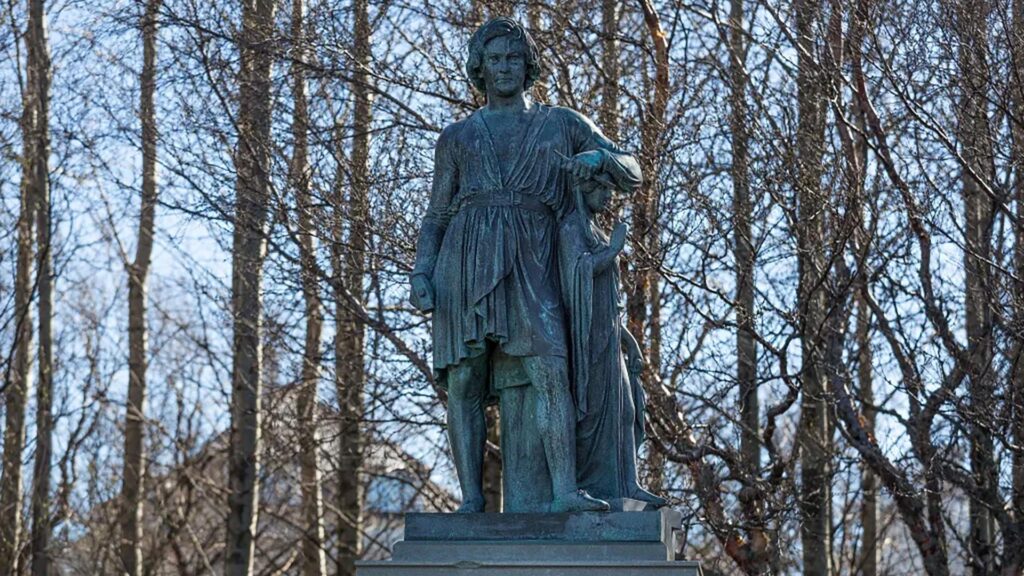
The next statue you will see is very classical. It is a self-portrait of the famous Sculpture Bertel Thorvaldsen leaning on another of his sculptures, The Goddess of Hope, from 1818. The Copenhagen City Council donated a bronze cast of this statue to the Icelandic people to mark the millennium of settlement in 1987. Bertel was half-Icelandic, and Icelanders have long been proud of that fact. This statue was the first outdoor artwork in Iceland.
Jónas Hallgrímsson By Einar Jónsson – 1905
Next to Bertel is a statue of Icelandic poet and natural scientist Jónas Hallgrímsson by Einar Jónsson. It is the first outdoor artwork by an Icelandic artist to be installed in Iceland. Jónas is important to Icelanders, and his birthday, November 16, is the Day of The Icelandic Tongue.
Adonis By Bertel Thorvaldsen – 1974 (original 1808)
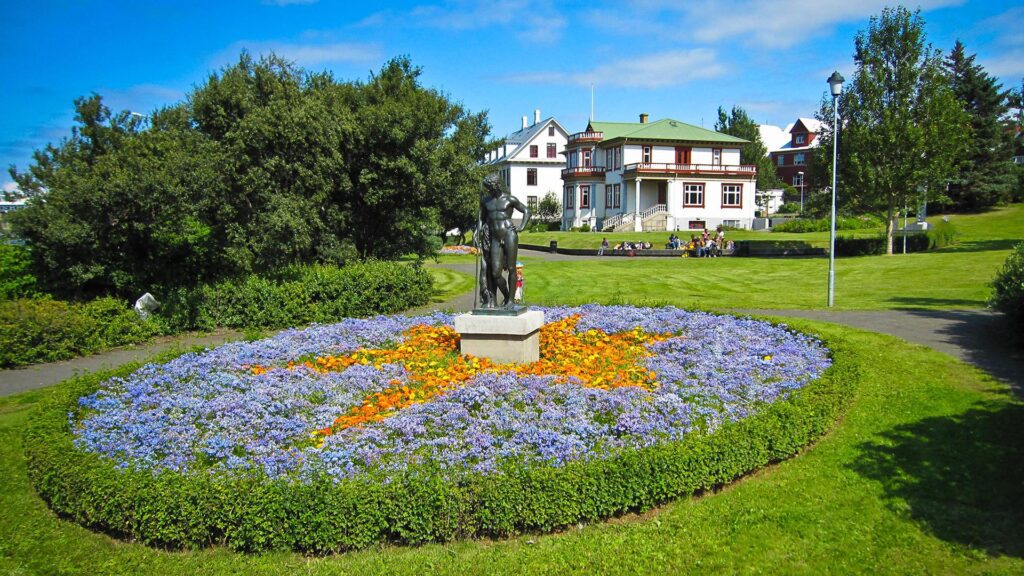
Walk towards the crossroads and cross the street. A large timber house with beautiful wood carvings clad with corrugated iron. It was the house of Thor Jensen and the family home of Ólafur Thors. At the garden’s entrance is a statue by Bertel Thorvaldsen of Adonis. The City of Reykjavik had a bronze cast made of Adonis. It was installed to mark the 1100th anniversary of the settlement in 1974. The original is in the Glyptotek Museum in Munich, Germany.
Gunnar Thoroddsen By Sigurjón Ólafsson – 1962
Close by is a bust on a pillar. It is of Gunnar Thoroddsen, former Prime Minister. He was born and raised at Fríkirkjuvegur 3. His father, Sigurður Thoroddsen, was the first Icelandic engineer and had the house built in 1905.
Thor Jensen and Margrét Þorbjörg Kristjánsdóttir Memorial By Helgi Gíslason – 1988-1989
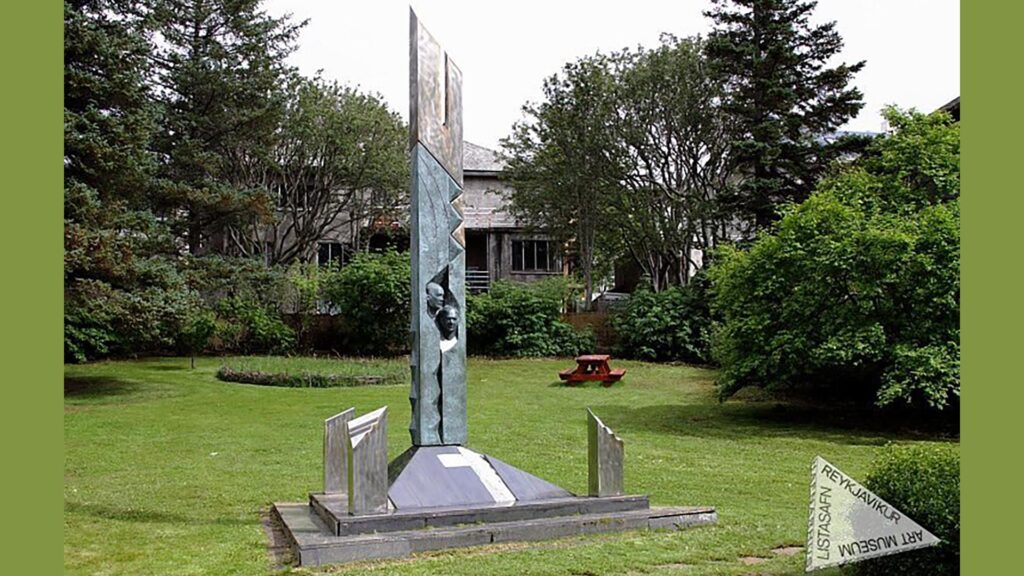
Up in the garden is a large sculpture. This is the monument for Thor Jensen and his wife, Margrét Þorbjörg Kristjánsdóttir. Thor was a Danish businessman who moved to Iceland in his youth. He originally opened a store in Iceland but was also involved with the fishing industry and dairy production. He had Korpúlfsstaðir, now in Reykjavik’s outskirts, built. It was, at that time, the largest dairy farm in the country.
Lad and Lass By Ásmundur Sveinsson – 1931-1933/1955
At the top of the garden is the sculptor Lad and Lass by Ásmundur Sveinsson. The original was made while the artist lived in France in the early 1930s. Later, he enlarged it and cast it in concrete. It was installed in Hallargarðurinn (The Palace Garden), as it is called, in 1955.
Girl By Ólöf Pálsdóttir – 1950
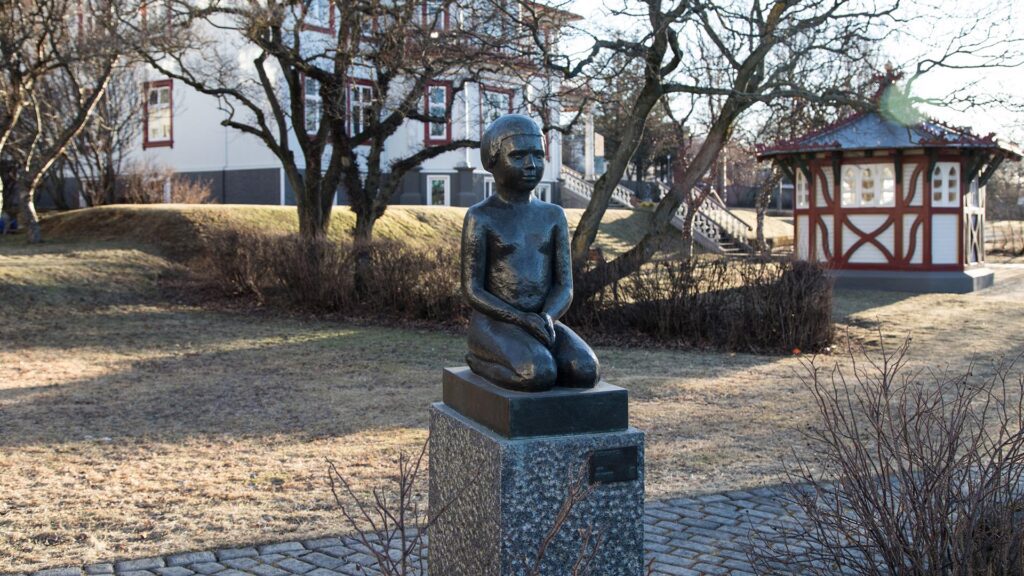
Keep walking towards the Centre of Reykjavik on this side of the road. In front of the building next to Fríkirkjuvegur 11 is a junior college, Kvennaskólinn. There is a small statue of a Girl. In 1964 a journalist wrote an article about the increasing number of statues in Reykjavik and said: “In Hallargarður Park, I met two children who were looking at the beautiful Girl by Ólfö Pálsdóttir which was installed there this summer. The children could not agree on the girl’s age; they looked at her for a long time and speculated. Artworks are not merely decoration. Beautiful art helps direct all our minds onto the right track to the benefit of all.
Mother Love By Nína Sæmundsson – 1924
Walk to the end of The Pond. On the right side of the street is a small park called the Maternal Park. The statue is by Nína Sæmundsson of Mother Love. The original was sent to Paris in 1924 for an exhibition. She used the last of her money to do so. Two years later, a bronze cast was erected in the garden, created specially for mothers and their children.
Monument for the Unknown Bureaucrat By Magnús Tómasson – 1993
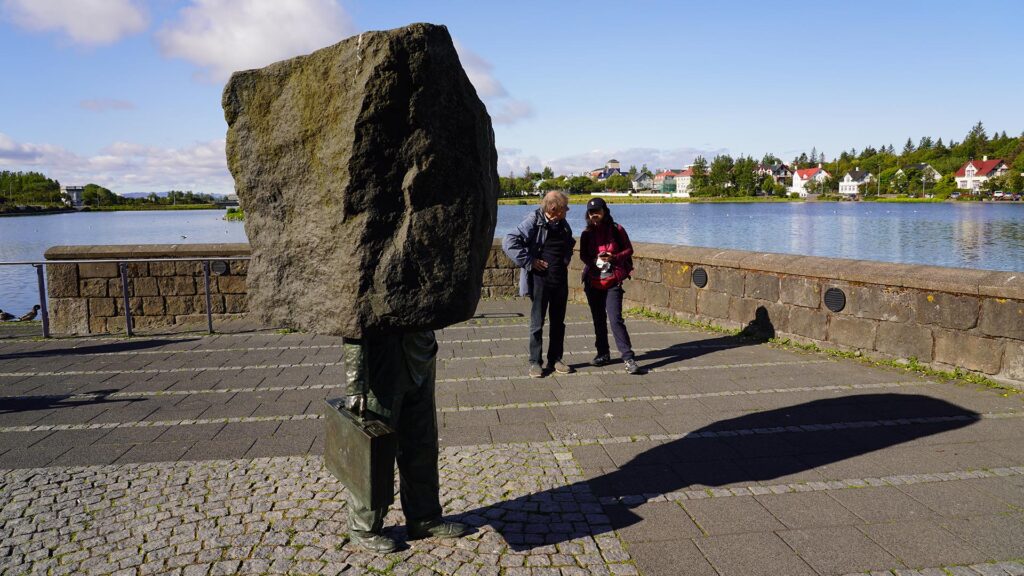
Cross the street next to The Pond. In front of Reykjavik City Hall, you will find the famous and fun sculpture Monument for the Unknown Bureaucrat. The work is made from basalt and bronze and is both figurative and abstract. It was originally behind Hótel Borg in a small square there. In 2012 it was moved to its current place at the initiative of Reykjavik Art Museum to make it more visible.
Tryggvi Gunnarsson By Ríkarður Jónsson – 1915
Walk towards Austurvöllur Square, between the Parliament Building and the Cathedral. In the Parliament Garden is a bust of Tryggvi Gunnarsson. He was a carpenter, a Member of Parliament, and the manager of Landsbankinn. What’s more, the statue stands next to his grave. The garden is his work, which he diligently attended in his old age. He loved it dearly and chose it as his final resting place.
Hallgrímur’s Harp By Júlíus Schou – 1885
Next to the Cathedral is a five-meter-high quadrilateral stone monument with a small harp on top. It refers to Rev. Hallgrímur Pétursson, Iceland’s greatest psalmist (Hallgrímskirkja Church is named after him).
Jón Vídalín By Ríkarður Jónsson – 1920
On the other side of the Cathedral, you will find two busts of men from the church. The first is of Jón Vídalín (1666-1720). He was a scholar, preacher, and the principal Latin poet of his time.
Rev. Bjarni Jónsson By Sigurjón Ólafsson – 1972
The next bust is of Rev. Bjarni Jónsson, who died in 1965. He was one of the best-known citizens of Reykjavik and cut quite a figure when walking between his home and the church in his cassock. He was more conservative in his religion than many other clergymen of his time.
The Face of the Sun By Ásmundur Sveinsson – 1961/1969
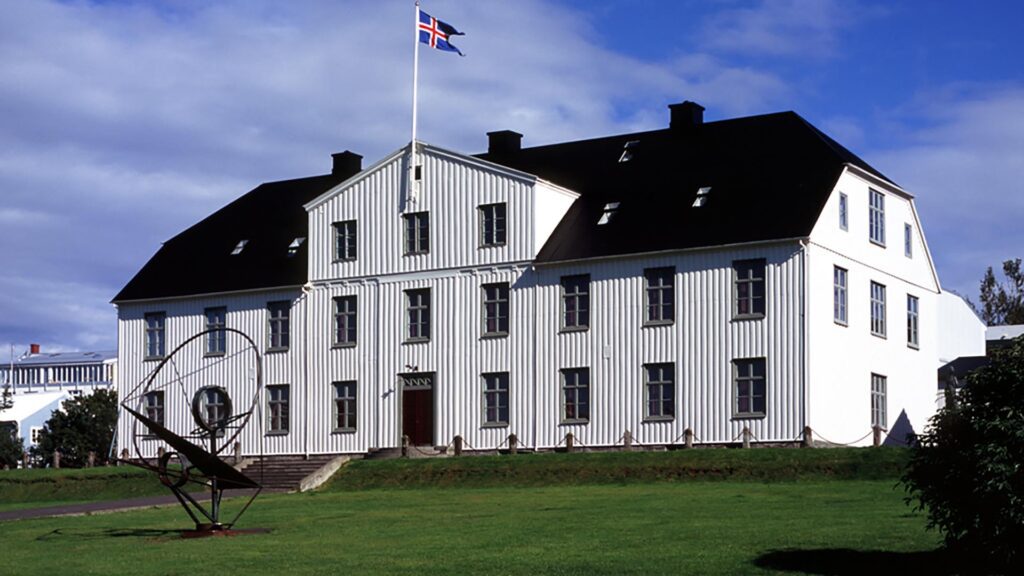
Walk towards the Menntaskóli of Reykjavík (MR) straight ahead. In the garden in front of the school is a large sculpture by Ásmundur Sveinsson. He originally made it in bronze in 1961. 8 years later, he enlarged it to eightfold its size and installed it in front of MR.
Pallas Athena By Myron – Unknown
Between the old MR building and the white library building is a statue of the war goddess Pallas Athena by the Greek sculptor Myron. The statue was a gift from the 25th anniversary of MR students in 1968. Athena was also the goddess of culture and wisdom. Despite being the goddess of war, she did not like warfare, unlike her brother Ares, the god of war. She would rather keep the peace and solve arguments peacefully. Athena is also the woman in the logo for the University of Iceland.
Rev. Friðrik and the Boy By Sigurjón Ólafsson – 1952
Walk in the direction of Harpa Concert Hall. You will see a statue of Rev. Friðrik and the Boy in the small park on the left of the school. The author Sigurjón had been taught Christian studies as a boy by the Reverend. And during WWII, they both got stuck in Denmark, where he made a bust of the Reverend. The bust was displayed in a Reykjavik gallery in 1952, but other former pupils of the aged Reverend suggested a worthy monument should be erected, which was done.
The Water Carrier By Ásmundur Sveinsson – 1937/1967
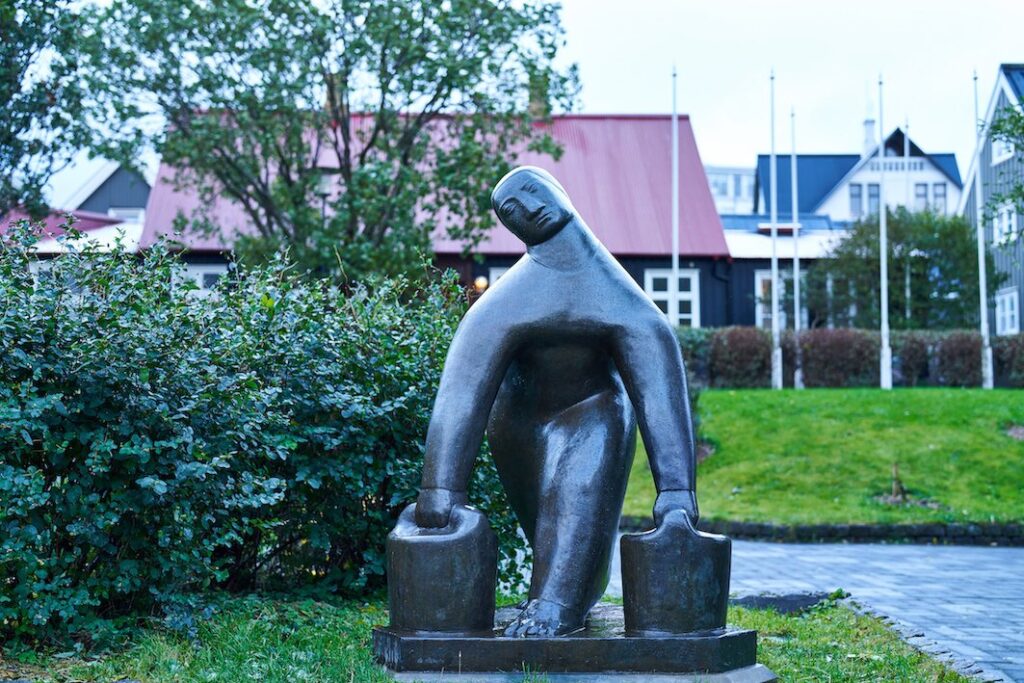
The final artwork of this walking tour is The Water Carrier by Ásmundur Sveinsson. He originally made it in 1936-1937. The sculpture was cast in bronze in 1967. It caused great controversy when the Reykjavik Beautification Society bought it; people did not like that the city wanted to glorify the poorest of workers in this way. It was supposed to be installed where it currently is but was erected in Öskjuhlíð, close to Perlan. It was moved to its rightful place in 2011.
We hope you enjoyed this walking tour around The Pond. Many other walking tours are available in the Reykjavik Art Museum App, which we highly recommend you check out.
Please signup HERE for our newsletter for more fun facts and information about Iceland!

